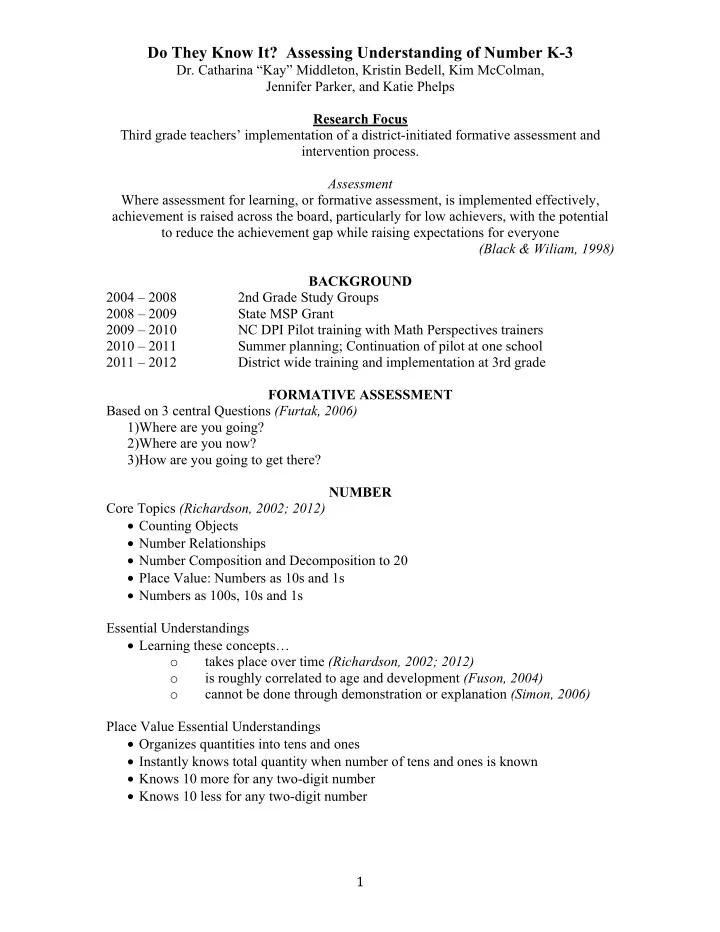

Do They Know It? Assessing Understanding of Number K-3 Dr. Catharina “Kay” Middleton, Kristin Bedell, Kim McColman, Jennifer Parker, and Katie Phelps Research Focus Third grade teachers’ implementation of a district-initiated formative assessment and intervention process. Assessment Where assessment for learning, or formative assessment, is implemented effectively, achievement is raised across the board, particularly for low achievers, with the potential to reduce the achievement gap while raising expectations for everyone (Black & Wiliam, 1998) BACKGROUND 2004 – 2008 2nd Grade Study Groups 2008 – 2009 State MSP Grant 2009 – 2010 NC DPI Pilot training with Math Perspectives trainers 2010 – 2011 Summer planning; Continuation of pilot at one school 2011 – 2012 District wide training and implementation at 3rd grade FORMATIVE ASSESSMENT Based on 3 central Questions (Furtak, 2006) 1) Where are you going? 2) Where are you now? 3) How are you going to get there? NUMBER Core Topics (Richardson, 2002; 2012) • Counting Objects • Number Relationships • Number Composition and Decomposition to 20 • Place Value: Numbers as 10s and 1s • Numbers as 100s, 10s and 1s Essential Understandings • Learning these concepts… o takes place over time (Richardson, 2002; 2012) o is roughly correlated to age and development (Fuson, 2004) o cannot be done through demonstration or explanation (Simon, 2006) Place Value Essential Understandings • Organizes quantities into tens and ones • Instantly knows total quantity when number of tens and ones is known • Knows 10 more for any two-digit number • Knows 10 less for any two-digit number 1 ¡
Do They Know It? Assessing Understanding of Number K-3 Dr. Catharina “Kay” Middleton, Kristin Bedell, Kim McColman, Jennifer Parker, and Katie Phelps FINDINGS Eight Themes Emerged as Challenges Teachers Faced 1) Purpose - clear and focused 2) Resources - relevant; commitment for classroom and PD 3) Preparation - adequate for training 4) Validity - evidence to support interpretations 5) Accommodations - to address learner needs without reducing validity 6) Compliance - the degree to which results are documented and used 7) Time - adequate to plan, implement, analyze, and use assessments & results 8) Disposition - positive, negative or neutral, in reaction to implementation Research Question 1: Implement a formative assessment process? Key Challenges: Time, Resources (Human & Material), Purpose Responses to Implementation-Based Disequilibrium: 1) Maintenance of Current Instructional Paradigm 2) Modification of Current Instructional Paradigm 3) Adoption of a New Instructional Paradigm Research Question 2: Make Sense of the Assessment Data? Key Challenges: Time Patterns of Response: 1) Instrumental – Instructional decisions based on score without considering underlying causes 2) Symbolic – Data are used to justify a predetermined viewpoint or decision 3) Conceptual – Data are used to identify patterns, provide evidence for explanation, and implement a strategy Research Question 3: Use data in making instructional decisions? Key Challenges: Time, Resources (Human & Material) Patterns of Response: 1) Resource – Outside the classroom, in addition to core instruction, using additional human resources 2) Intervention – Within or across classrooms, in addition to core instruction, using existing human resources 3) Differentiation – Within the classroom, during core instruction, most difficult Research Question 4: Impact on Students’ Understanding Differences in scores from Pre-Test to Post-Test were significant • t (338) = 38.535, p < .001 • effect size d = 1.58 o An effect size of "1.0" indicates that a particular approach to teaching or technique advanced the learning of the students in the study by one standard deviation above the mean. (Hattie, 2009) o effect size of : 0.2 “small” ; 0.5 “medium”; 0.8 “large” (Pinchok & Brandt, 2009) 2 ¡
Do They Know It? Assessing Understanding of Number K-3 Dr. Catharina “Kay” Middleton, Kristin Bedell, Kim McColman, Jennifer Parker, and Katie Phelps IMPLICATIONS Systemic Approach to Train, Empower, and Support: Teachers • Assessment Literacy (Stiggins, 2002) • Mathematical Knowledge for Teaching (Ball et al., 2008) • Next Instructional Steps (Heritage et al., 2009) Principals • Assessment Literacy (Stiggins, 2002) • Effects on Teachers and Schools (Pinchok & Brandt, 2009) • Reallocate Resources (Wylie & Lyon, 2009) District Administrators • Assessment Literacy (Stiggins, 2002) • Conflicting Policies & Practices (Black et al., 2004) • Sustained Professional Development (Darling-Hammond et al., 2009) • Reallocation of Resources (Wylie & Lyon, 2009) KEY FINDINGS: 1) Anticipate, identify, and address the challenges teachers face as quickly and efficiently as possible. 2) Include and support principals and district administrators throughout the process so they can, in turn, support the teachers. 3) Focus on improving teachers’ data literacy, including increasing teachers’ mathematics content knowledge. CONCLUSION When teachers seek, or at least are open to, feedback from students as to what students know, what they understand, where they make errors, when they have misconceptions, when they are not engaged - then teaching and learning can be synchronized and powerful. Feedback to teachers helps make learning visible. (Hattie, 2009) Contact Us Kay Middleton ringerc@ecu.edu Kristin Bedell kristin.bedell@orange.k12.nc.us Kim McColman kim.mccolman@orange.k12.nc.us Jennifer Parker jennifer.parker@orange.k12.nc.us Katie Phelps katie.phelps@orange.k12.nc.us 3 ¡
Recommend
More recommend